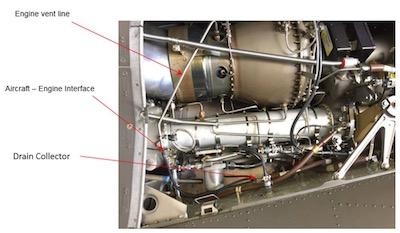Mon, Nov 27, 2017
January Accident May Be Related To Problem With Engine Oil Drain System
The FAA has issued a Special Airworthiness Information Bulletin (SAIB) warning of a possible blockage of the engine oil drainage system on Airbus Helicopters Deutschland (Airbus Helicopters) Model MBB-BK 117 C-2 helicopters.

On January 26, 2017 an operator of a BK117 C-2 experienced an in-flight engine fire and made an emergency landing in Sioux Falls, South Dakota. Although still under investigation, the engine fire could be related to engine oil coke chips plugging the return scavenge line for the rear bearing of the gas generator. On September 8, 2017 a BK117 C-2 helicopter was destroyed when it crashed near Hertford, North Carolina. The NTSB preliminary investigation found that the number 2 engine rear turbine shaft bearing exhibited discoloration consistent with overheating and lack of lubrication. Through the course of inspecting the engine issue for scavenge line blockage, a BK117 C-2 operator discovered a separate, airframe-related issue. The operator detected various levels of coking blockage of engine drain lines. Airbus Helicopters prescribes a general visual inspection of the bearing compartment area. There are no prescribed inspections of the drain tube or drain collector to check for blockage. A blocked
drain line may, under certain circumstances, present a risk for an engine fire and/or inflight shutdown of the affected engine.
The FAA recommends the actions below for all owners, operators, and maintainers of Airbus Helicopters BK117 C-2 helicopters. The actions should be performed for each engine at intervals not to exceed 100 hours time-in-service (TIS). Refer to Fig. 01 in Airbus Helicopters AMM 71-71-01, dated March 1, 2016 and to Figure 1 of this SAIB.
Disconnect the rear bearing lines part numbers AE709636-1 (hose), 117-600381.111 (hose), and 117-600381.105 (hose) from the drain collector part number B717M1028801 or 117-602061 (drain collector) and disconnect the drain collector from the engine deck.
Visually check the drain collector and hoses for obstructions. These obstructions may include carbon and coke deposits. Contact Airbus Helicopters for recommended cleaning procedures if there are any obstructions.
If there are no obstructions or after performing the above actions, reconnect the drain collector to the engine deck and reconnect the drain/vent lines to the drain collector per approved maintenance instructions.
(Image provided with FAA SAIB)
More News
He Attempted To Restart The Engine Three Times. On The Third Restart Attempt, He Noticed That Flames Were Coming Out From The Right Wing Near The Fuel Cap Analysis: The pilot repor>[...]
Make Sure You NEVER Miss A New Story From Aero-News Network Do you ever feel like you never see posts from a certain person or page on Facebook or Instagram? Here’s how you c>[...]
From 2009 (YouTube Edition): Leading Air Show Performers Give Their Best Advice for Newcomers On December 6th through December 9th, the Paris Las Vegas Hotel hosted over 1,500 air >[...]
Aero Linx: NASA ASRS ASRS captures confidential reports, analyzes the resulting aviation safety data, and disseminates vital information to the aviation community. The ASRS is an i>[...]
“For our inaugural Pylon Racing Seminar in Roswell, we were thrilled to certify 60 pilots across our six closed-course pylon race classes. Not only did this year’s PRS >[...]
 NTSB Final Report: Rutan Long-EZ
NTSB Final Report: Rutan Long-EZ ANN FAQ: Turn On Post Notifications
ANN FAQ: Turn On Post Notifications Classic Aero-TV: ICAS Perspectives - Advice for New Air Show Performers
Classic Aero-TV: ICAS Perspectives - Advice for New Air Show Performers ANN's Daily Aero-Linx (06.28.25)
ANN's Daily Aero-Linx (06.28.25) Aero-News: Quote of the Day (06.28.25)
Aero-News: Quote of the Day (06.28.25)



